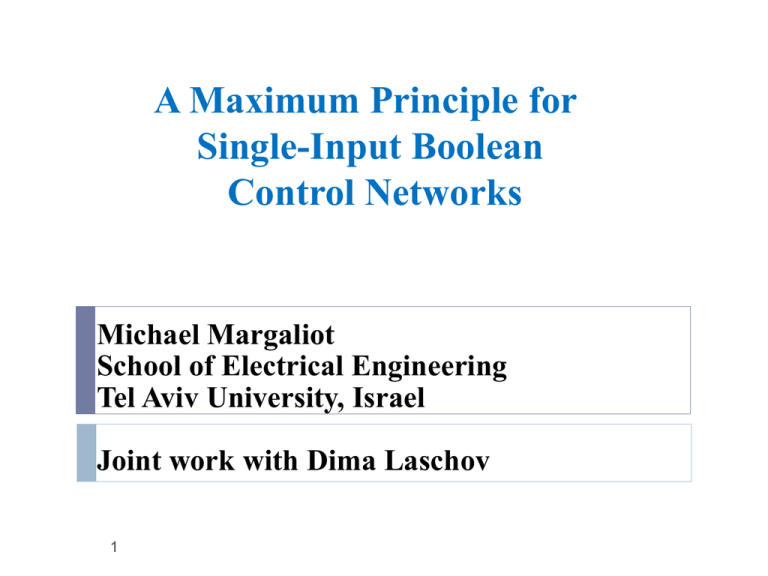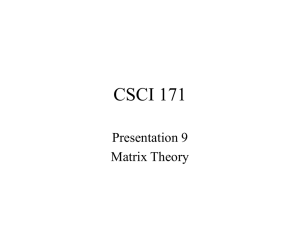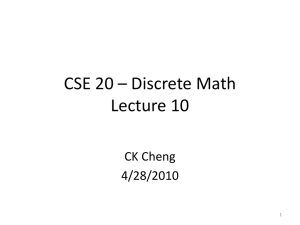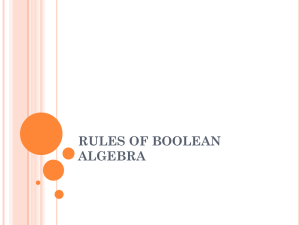Semi—Tensor Product of Matrices
advertisement

A Maximum Principle for
Single-Input Boolean
Control Networks
Michael Margaliot
School of Electrical Engineering
Tel Aviv University, Israel
Joint work with Dima Laschov
1
Layout
2
Boolean Networks (BNs)
Applications of BNs in systems biology
Boolean Control Networks (BCNs)
Algebraic representation of BCNs
An optimal control problem
A maximum principle
An example
Conclusions
Boolean Networks (BNs)
or
x1
x2
and
A BN is a discrete-time logical dynamical system:
x1 (k 1) f1 ( x1 (k ),
xn (k )),
(1)
xn (k 1) f n ( x1 (k ),
xn (k )),
where xi () {True,False} and f i is a Boolean function.
→ A finite number of possible states.
3
A Brief Review of a Long History
BNs date back to the early days of switching
theory, artificial neural networks, and cellular
automata.
4
BNs in Systems Biology
S. A. Kauffman (1969) suggested using BNs
for modeling gene regulation networks.
Modeling
5
gene
expressed/not expressed
network interactions
Analysis
state-variable
True/False
Boolean functions
stable genetic state
robustness
attractor
basin of attraction
BNs in Systems Biology
BNs have been used for modeling numerous
genetic and cellular networks:
1.
Cell-cycle regulatory network of the
budding yeast (F. Li et al, PNAS, 2004);
2.
Transcriptional network of the yeast
(Kauffman et al, PNAS, 2003);
3.
Segment polarity genes in Drosophila
melanogaster (R. Albert et al, JTB, 2003);
4.
ABC network controlling floral organ cell
fate in Arabidopsis (C. Espinosa-Soto, Plant
Cell, 2004).
6
BNs in Systems Biology
5.
6.
7
Signaling network controlling the stomatal
closure in plants (Li et al, PLos Biology,
2006);
Molecular pathway between dopamine and
glutamate receptors (Gupta et al, JTB, 2007);
BNs with control inputs have been used to
design and analyze therapeutic intervention
strategies (Datta et al., IEEE MAG. SP, 2010,
Liu et al., IET Systems Biol., 2010).
Single—Input Boolean Control Networks
where:
x1 (k 1) f1 ( x1 (k ),
xn (k ), u (k )),
xn (k 1) f n ( x1 (k ),
xn (k ), u (k )),
xi (), u() {True,False}
fi
is a Boolean function
Useful for modeling biological networks with a
controlled input.
8
Algebraic Representation of BCNs
State evolution of BCNs:
x(k ) f ... f ( f ( x(0), u(0)), u(1))...).
Daizhan Chen developed an algebraic
representation for BNs using the semi—tensor
product of matrices.
9
Semi—Tensor Product of Matrices
Definition Kronecker product of A R mn and B R pq
a11 B
A B
a B
n1
a1n B
( mp )( nq )
R
.
ann B
Let lcm(a, b) denote the least common multiplier of a, b.
For example, lcm(6,8) 24.
Definition semi-tensor product of A R mn and B R pq
Aâ B ( A Iα / n )(
) (B
B
IIαα//pp))
where α lcm(n, p).
10
( mα / n )( nα / n ) ( pα / p )( qα / p )
Semi—Tensor Product of Matrices
Aâ B ( A Iα / n )(B Iα / p ).
A generalization of the standard matrix product to
matrices with arbitrary dimensions.
Properties:
Aâ ( Bâ C ) ( Aâ B)â C
( A B)â C ( Aâ C ) ( B â C )
11
Semi—Tensor Product of Matrices
Aâ B ( A Iα / n )(B Iα / p ).
0 1
Example Suppose that a, b { , }.
1 0
v
a â b â
v
v
0
w v
w
( I 2 )( I1 )
v
w v
w
0
Then
0
vw
v w vw
0 w vw
v
vw
All the minterms of the two Boolean variables.
12
Algebraic Representation of
Boolean Functions
Represent Boolean values as:
1
True e ,
0
1
0
False e .
1
2
Theorem (Cheng & Qi, 2010). Any Boolean function
f :{e1, e2}n {e1, e2}
may be represented as
f ( x1,..., xn ) M f â x1 â x2 â ...â xn
is the structure matrix of f .
where M f R
Proof This is the sum of products representation of f .
2 x 2n
13
Algebraic Representation of
Single-Input BCNs
Theorem Any BCN
x1 (k 1) f1 ( x1 (k ),
xn (k ), u (k )),
xn (k 1) f n ( x1 (k ),
xn (k ), u (k )),
may be represented as
x(k 1) Lâ u(k )â x(k )
where
14
n1
L R2 2
n
is the transition matrix of the BCN.
BCNs as Boolean Switched Systems
x(k 1) L â u(k ) â x(k )
u (k ) e
1
x(k 1) L1 â x(k )
15
u (k ) e 2
x(k 1) L2 â x(k )
Optimal Control Problem for BCNs
Fix an arbitrary x(0) and an arbitrary final time
Denote U u(0), u( N 1), u(i) e , e .
Fix a vector r R2 .
Define a cost-functional: J (u) rT x( N , u). (4)
Problem: find a control u U that maximizes J .
1
N 0.
2
n
Since x( N , u) contains all minterms, any Boolean
function of the state at time N may be represented
as rT x( N , u).
16
Main Result: A Maximum Principle
Theorem Let u * be an optimal control.
Define the adjoint : 1, N R 2 by:
n
(s) ( Lâ u (s))T â (s 1), ( N ) r,
and the switching function m : 0,1
by:
1
(5)
N 1 R
m(s) T (s 1)â Lâ â x* (s).
1
Then
17
e1 , if m(s) 0,
u *( s) 2
e , if m(s) 0.
(6)
Comments on the Maximum Principle
e1 , if m(s) 0,
u *( s) 2
e , if m(s) 0.
18
(6)
The MP provides a necessary condition for
optimality.
Structurally similar to the Pontryagin MP:
adjoint, switching function, two-point
boundary value problem.
The Singular Case
e1 , if m(s) 0,
u *( s) 2
e , if m(s) 0.
(6)
Theorem If m(s) 0, then there exists an
optimal control u * satisfying u *(s) e1,
and there exists an optimal control w *
satisfying w *(s) e2 .
19
Proof of the MP: Transition Matrix
x(k 1) L â u(k ) â x(k )
Recall
so
x(k 2) Lâ u(k 1)â x(k 1) L â u (k 1)â L â u (k )â x(k ).
More generally,
x( k ; u ) C ( k , j ; u ) â x( j ; u )
C (k , j; u) L â u(k 1) â L â u(k 2) â ...â L â u( j ).
C (k , j; u) is called the transition matrix from
time j to time k corresponding to the control u.
20
Proof of the MP: Needle Variation
Suppose that u * is an optimal control. Fix a time
p {0,1,..., N 1} and v {e1 , e2}.
Define
jp
v,
u( j )
u *( j ), otherwise.
u( j)
v
0
21
p
N 1
j
Proof of the MP: Needle Variation
Then
x *( N ) C ( N , p 1; u*) â Lâ u *( p) â x *( p)
x( N ) C ( N , p 1; u ) â L â u ( p) â x( p)
C ( N , p 1; u*) â L â v â x *( p)
This yields
x *( N ) x( N ) C( N , p 1; u*) â L â (u *( p) v) â x *( p)
so
J (u*) J (u ) r T ( x *( N ) x( N ))
r T C ( N , p 1; u*) â L â (u *( p) v) â x *( p)
?
22
Proof of the MP: Needle Variation
J (u*) J (u ) r T ( x *( N ) x( N ))
r T C ( N , p 1; u*) â L â (u *( p) v) â x *( p).
?
Recall the definition of the adjoint
(s) ( Lâ u (s))T â (s 1), ( N ) r,
so
J (u*) J (u ) r T ( x *( N ) x( N ))
T ( p 1) â L â (u *( p) v) â x *( p).
This provides an expression for the effect of the
needle variation.
23
Proof of the MP
J (u*) J (u) T ( p 1)â Lâ (u *( p) v)â x *( p).
Suppose that
1 *
m( p) ( p 1)â L â â x ( p) 0.
1
If u *( p) e1, take v e2 . Then
1 0
T
J (u*) J (u ) ( p 1) â L â ( ) â x *( p)
0 1
T
0,
so u is also optimal. This proves the result in
the singular case. The proof of the MP is similar.
24
An Example
Consider the BCN
x1 (k 1) u(k ) x2 (k )
x2 (k 1) u(k ) x1 (k ) x2 (k )
x1 (0) x2 (0) False.
Consider the optimal control problem with N 3
and r [1 0 0 0]T . This amounts to finding a control
steering the system to x1 (3) x2 (3) True.
25
An Example
The algebraic state space form:
x(k 1) L â u(k ) â x(k )
x(0) [0 0 0 1]T
with
0
0
L
1
0
26
1
0
0
0
0
0
1
0
1
0
0
0
0
0
0
1
0
0
1
0
0
0
1
0
0
0
.
1
0
An Example
Analysis using the MP:
1 *
m(2) (3) â L â â x (2)
1
1 *
T
r â L â â x (2)
1
T
[0 1 0 1]â x* (2).
This means that m(2) 0, so u *(2) e1. Now
(2) ( L â u * (2))T (3)
[0 1 0 1]T .
27
An Example
We can now calculate
1 *
m(1) (2) â L â â x (1)
1
[1 0 0 0]â x* (1).
T
This means that m(1) 0, so u *(1) e2 .
Proceeding in this way yields
u *(2) e1, u *(1) e2 , u *(0) e1.
28
Conclusions
We considered a Mayer –type optimal control
problem for single –input BCNs.
We derived a necessary condition for optimality in
the form of an MP.
Further research:
(1) analysis of optimal controls in BCNs that model
real biological systems,
(2) developing a geometric theory of optimal control
for BCNs.
For more information, see
http://www.eng.tau.ac.il/~michaelm/
29










